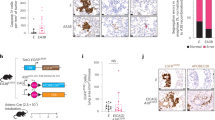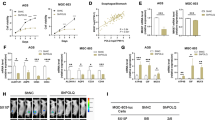Abstract
Prostate cancer (PCa) is a commonly diagnosed malignancy in men. The transcription factor p53, a well-known cancer suppressor, has been extensively analyzed in the progression of many tumor types, but its involvement in PCa remains not fully understood. Hence, this study aims to explore the possible molecular mechanism underlying p53 in the growth and metastasis of PCa. Based on bioinformatics analysis findings of GEPIA and starBase databases, p53 was demonstrated to be involved in the development of PCa by transcriptionally activating microRNA-519d-3p (miR-519d-3p) expression to suppress the expression of E2F transcription factor 1 (E2F1) and CD147. In order to verify this finding, clinically-obtained PCa tumor tissues were enrolled and commercially-purchased PCa cell lines were used to detect the cell viability, cycle, and apoptosis, as well as invasion and migration by CCK-8, flow cytometry, and Transwell assays respectively. The results of clinical tissue experiments and in vitro cell experiments showed that miR-519d-3p and p53 were poorly-expressed in PCa tissues and cell lines, while E2F1 was highly-expressed. Overexpression of miR-519d-3p led to inhibited PCa cell proliferation, invasion and migration, and p53 overexpression was found to promote miR-519d-3p expression to suppress the malignant characteristics of PCa cells, while the additional E2F1 overexpression restored the malignant traits. Moreover, ChIP analysis and dual-luciferase reporter assay confirmed the interactions among p53, miR-519d-3p, and E2F1. Mechanistically, it was found that p53 transcriptionally activated miR-519d-3p to suppress E2F1 expression. Finally, the in vitro results were further validated by in vivo experiments, which showed that miR-519d-3p prevents tumorigenesis and lymph node metastasis of PCa in nude mice via negatively regulation of E2F1 and CD147. Taken together, the findings uncover that the transcription factor p53 could upregulate miR-519d-3p expression to directly suppress the expression of E2F1, thus inhibiting PCa growth and metastasis. It highlights a novel therapeutic strategy against PCa based on the p53/miR-519d-3p/E2F1 regulatory pathway.
This is a preview of subscription content, access via your institution
Access options
Subscribe to this journal
Receive 12 print issues and online access
$259.00 per year
only $21.58 per issue
Buy this article
- Purchase on Springer Link
- Instant access to full article PDF
Prices may be subject to local taxes which are calculated during checkout







Similar content being viewed by others
References
Ferlay J, Soerjomataram I, Dikshit R, Eser S, Mathers C, Rebelo M, et al. Cancer incidence and mortality worldwide: sources, methods and major patterns in GLOBOCAN 2012. Int J Cancer. 2015;136:E359–86.
Altwaijry N, Somani S, Dufes C. Targeted nonviral gene therapy in prostate cancer. Int J Nanomed. 2018;13:5753–67.
Joerger AC, Fersht AR. The p53 pathway: origins, inactivation in cancer, and emerging therapeutic approaches. Annu Rev Biochem. 2016;85:375–404.
Bykov VJN, Eriksson SE, Bianchi J, Wiman KG. Targeting mutant p53 for efficient cancer therapy. Nat Rev Cancer. 2018;18:89–102.
Quinn DI, Stricker PD, Kench JG, Grogan J, Haynes AM, Henshall SM, et al. p53 nuclear accumulation as an early indicator of lethal prostate cancer. Br J Cancer. 2019;121:578–83.
Hamid AA, Gray KP, Shaw G, MacConaill LE, Evan C, Bernard B, et al. Compound genomic alterations of TP53, PTEN, and RB1 tumor suppressors in localized and metastatic prostate cancer. Eur Urol. 2019;76:89–97.
Wang Y, Zhang YX, Kong CZ, Zhang Z, Zhu YY. Loss of P53 facilitates invasion and metastasis of prostate cancer cells. Mol Cell Biochem. 2013;384:121–7.
Sharma N, Baruah MM. The microRNA signatures: aberrantly expressed miRNAs in prostate cancer. Clin Transl Oncol. 2019;21:126–44.
Li X, Han X, Yang J, Sun J, Wei P. Overexpression of miR-519d-3p inhibits the proliferation of DU-145 prostate cancer cells by reducing TRAF4. Xi Bao Yu Fen Zi Mian Yi Xue Za Zhi. 2018;34:16–21.
Fornari F, Milazzo M, Chieco P, Negrini M, Marasco E, Capranico G, et al. In hepatocellular carcinoma miR-519d is upregulated by p53 and DNA hypomethylation and targets CDKN1A/p21, PTEN, AKT3, and TIMP2. J Pathol. 2012;227:275–85.
Yu Y, Zhao D, Li K, Cai Y, Xu P, Li R, et al. E2F1 mediated DDX11 transcriptional activation promotes hepatocellular carcinoma progression through PI3K/AKT/mTOR pathway. Cell Death Dis. 2020;11:273.
Zhou Q, Wang C, Zhu Y, Wu Q, Jiang Y, Huang Y, et al. Key genes and pathways controlled By E2F1 in human castration-resistant prostate cancer cells. Onco Targets Ther. 2019;12:8961–76.
Sang XB, Zong ZH, Wang LL, Wu DD, Chen S, Liu BL, et al. E2F-1 targets miR-519d to regulate the expression of the ras homolog gene family member C. Oncotarget 2017;8:14777–93.
Liang YX, Lu JM, Mo RJ, He HC, Xie J, Jiang FN, et al. E2F1 promotes tumor cell invasion and migration through regulating CD147 in prostate cancer. Int J Oncol. 2016;48:1650–8.
Ye Y, Li SL, Wang Y, Yao Y, Wang J, Ma YY, et al. The role of CD147 expression in prostate cancer: a systematic review and meta-analysis. Drug Des Devel Ther. 2016;10:2435–42.
Zhou C, Liu HS, Wang FW, Hu T, Liang ZX, Lan N, et al. circCAMSAP1 promotes tumor growth in colorectal cancer via the miR-328-5p/E2F1 axis. Mol Ther. 2020;28:914–28.
Peng X, Zhang Y, Gao J, Cai C. MiR-1258 promotes the apoptosis of cervical cancer cells by regulating the E2F1/P53 signaling pathway. Exp Mol Pathol. 2020;114:104368.
Fang Z, Yang H, Chen D, Shi X, Wang Q, Gong C, et al. YY1 promotes colorectal cancer proliferation through the miR-526b-3p/E2F1 axis. Am J Cancer Res. 2019;9:2679–92.
Kang F, Ma W, Ma X, Shao Y, Yang W, Chen X, et al. Propranolol inhibits glucose metabolism and 18F-FDG uptake of breast cancer through posttranscriptional downregulation of hexokinase-2. J Nucl Med. 2014;55:439–45.
Li Q, Ye L, Zhang X, Wang M, Lin C, Huang S, et al. FZD8, a target of p53, promotes bone metastasis in prostate cancer by activating canonical Wnt/beta-catenin signaling. Cancer Lett. 2017;402:166–76.
Yan CQ, Lu YH, Tang SM, Fan WX. MiR-519d inhibits prostate cancer cell proliferation, cycle, and invasion via targeting NRBP1. Eur Rev Med Pharm Sci. 2018;22:2985–90.
Qi JC, Yang Z, Zhang YP, Lu BS, Yin YW, Liu KL, et al. miR-20b-5p, TGFBR2, and E2F1 form a regulatory loop to participate in epithelial to mesenchymal transition in prostate cancer. Front Oncol. 2019;9:1535.
Li D, Song H, Wu T, Xie D, Hu J, Zhao J, et al. MiR-519d-3p suppresses breast cancer cell growth and motility via targeting LIM domain kinase 1. Mol Cell Biochem. 2018;444:169–78.
Gupta S, Silveira DA, Mombach JCM. Modeling the role of microRNA-449a in the regulation of the G2/M cell cycle checkpoint in prostate LNCaP cells under ionizing radiation. PLoS One. 2018;13:e0200768.
Zhang W, Hong W. Upregulation of miR-519d-3p inhibits viability, proliferation, and G1/S cell cycle transition of oral squamous cell carcinoma cells through targeting CCND1. Cancer Biother Radiopharm. 2020. https://doi.org/10.1089/cbr.2020.3984.
Zhang G, Hu Y, Yuan W, Qiu H, Yu H, Du J. miR-519d-3p overexpression inhibits P38 and PI3K/AKT pathway via targeting VEGFA to attenuate the malignant biological behavior of non-small cell lung cancer. Onco Targets Ther. 2020;13:10257–66.
Ding J, Huang F, Wu G, Han T, Xu F, Weng D, et al. MiR-519d-3p suppresses invasion and migration of trophoblast cells via targeting MMP-2. PLoS One. 2015;10:e0120321.
Li YY, Shao JP, Zhang SP, Xing GQ, Liu HJ. miR-519d-3p inhibits cell proliferation and invasion of gastric cancer by downregulating B-cell lymphoma 6. Cytogenet Genome Res. 2018;154:12–9.
Sui X, Cai J, Li H, He C, Zhou C, Dong Y, et al. p53-dependent CD51 expression contributes to characteristics of cancer stem cells in prostate cancer. Cell Death Dis. 2018;9:523.
Wan J, Zhang J, Zhang J. Expression of p53 and its mechanism in prostate cancer. Oncol Lett. 2018;16:378–82.
Pascal LE, Wang Y, Zhong M, Wang D, Chakka AB, Yang Z, et al. EAF2 and p53 co-regulate STAT3 activation in prostate cancer. Neoplasia 2018;20:351–63.
Downing SR, Russell PJ, Jackson P. Alterations of p53 are common in early stage prostate cancer. Can J Urol. 2003;10:1924–33.
Kluth M, Harasimowicz S, Burkhardt L, Grupp K, Krohn A, Prien K, et al. Clinical significance of different types of p53 gene alteration in surgically treated prostate cancer. Int J Cancer. 2014;135:1369–80.
Kalra RS, Cheung CT, Chaudhary A, Prakash J, Kaul SC, Wadhwa R. CARF (Collaborator of ARF) overexpression in p53-deficient cells promotes carcinogenesis. Mol Oncol. 2015;9:1877–89.
Luo Z, Cui R, Tili E, Croce C. Friend or Foe: MicroRNAs in the p53 network. Cancer Lett. 2018;419:96–102.
Suh SO, Chen Y, Zaman MS, Hirata H, Yamamura S, Shahryari V, et al. MicroRNA-145 is regulated by DNA methylation and p53 gene mutation in prostate cancer. Carcinogenesis 2011;32:772–8.
Zeng HZ, Qu YQ, Liang AB, Deng AM, Zhang WJ, Xiu B, et al. Expression of CD147 in advanced non-small cell lung cancer correlated with cisplatin-based chemotherapy resistance. Neoplasma. 2011;58:449–54.
Grass GD, Toole BP. How, with whom, and when: an overview of CD147-mediated regulatory networks influencing matrix metalloproteinase activity. Biosci Rep. 2015;36:e00283.
Zhu H, Zhao J, Zhu B, Collazo J, Gal J, Shi P, et al. EMMPRIN regulates cytoskeleton reorganization and cell adhesion in prostate cancer. Prostate. 2012;72:72–81.
Wang C, Xu C, Niu R, Hu G, Gu Z, Zhuang Z. MiR-890 inhibits proliferation and invasion and induces apoptosis in triple-negative breast cancer cells by targeting CD147. BMC Cancer. 2019;19:577.
Qiu K, Huang Z, Huang Z, He Z, You S. miR-22 regulates cell invasion, migration, and proliferation in vitro through inhibiting CD147 expression in tongue squamous cell carcinoma. Arch Oral Biol. 2016;66:92–7.
Schmidt AK, Pudelko K, Boekenkamp JE, Berger K, Kschischo M, Bastians H. The p53/p73-p21(CIP1) tumor suppressor axis guards against chromosomal instability by restraining CDK1 in human cancer cells. Oncogene 2021;40:436–51.
Alesse E, Zazzeroni F, Angelucci A, Giannini G, Di Marcotullio L, Gulino A. The growth arrest and downregulation of c-myc transcription induced by ceramide are related events dependent on p21 induction, Rb underphosphorylation, and E2F sequestering. Cell Death Differ. 1998;5:381–9.
Tong R, Wu X, Liu Y, Liu Y, Zhou J, Jiang X, et al. Curcumin-induced DNA demethylation in human gastric cancer cells is mediated by the DNA-damage response pathway. Oxid Med Cell Longev. 2020;2020:2543504.
Li WF, Herkilini A, Tang Y, Huang P, Song GB, Miyagishi M, et al. The transcription factor PBX3 promotes tumor cell growth through transcriptional suppression of the tumor suppressor p53. Acta Pharmacol Sin. 2021. https://doi.org/10.1038/s41401-020-00599-9.
Funding
This study was supported by Free Exploration and Innovation Project of Xi’an Jiaotong University (Grant No.: XJJ2018138) and Natural Science Basic Research Project of Shaanxi Province (Grant No.: 2018JM7093).
Author information
Authors and Affiliations
Contributions
DZ, LX, and TC designed the study. X-JY and Q-DL were involved in data collection. DZ and LX performed the statistical analysis and preparation of figures. DZ and TC drafted and polished the paper. All authors read and approved the final manuscript.
Corresponding author
Ethics declarations
Competing interests
The authors declare no competing interests.
Additional information
Publisher’s note Springer Nature remains neutral with regard to jurisdictional claims in published maps and institutional affiliations.
Supplementary information
Rights and permissions
About this article
Cite this article
Zhang, D., Yang, XJ., Luo, QD. et al. Transcription factor p53-mediated activation of miR-519d-3p and downregulation of E2F1 attenuates prostate cancer growth and metastasis. Cancer Gene Ther 29, 1001–1011 (2022). https://doi.org/10.1038/s41417-021-00405-6
Received:
Revised:
Accepted:
Published:
Issue Date:
DOI: https://doi.org/10.1038/s41417-021-00405-6
This article is cited by
-
DLGAP5 triggers proliferation and metastasis of bladder cancer by stabilizing E2F1 via USP11
Oncogene (2024)
-
Circ_0008726 promotes malignant progression of ESCC cells through miR-206/HOXA13 pathway
General Thoracic and Cardiovascular Surgery (2023)



